Out of the shadows? The Ministry of Defence’s real UFO expert
The identity of the defence expert responsible for the UK’s ‘definitive report’ on UFOs has been outed by the author of a new book on the Rendlesham Forest incident. David Clarke reports on his research into the elusive figure behind the Condign report.
It is 14 years since I left the Ministry of Defence (MoD) Main Building in Whitehall holding one of only a handful of hard copies of the 463 page, 3 volume report Unidentified Aerial Phenomena in the UK Air Defence Region, codenamed ‘Condign’ by its elusive (and at that point anonymous) author. The penultimate UFO desk officer Linda Unwin was, like all MoD staff, subject to the Official Secrets Act. She was responsible for releasing the redacted text to me after I used the Freedom of Information Act to release it from the secret vault of the Defence Intelligence Staff (DIS). For years the MoD had maintained that Linda’s department were the focal point for all British government interest. But the report she handed over made it clear this was far from the whole story. Condign was a project funded entirely by the Defence Intelligence branch DI55 that had kept tabs on UFO reports since the mid-1960s when they inherited the task from the former Air Ministry.
Files released at The National Archives revealed that DI55’s main responsibility was guided missiles and space weapons. UFOs or UAPs were a spin-off task inherited from the Cold War era. Anything unidentified that entered Earth’s atmosphere was of interest to DI55’s ‘space desk’ and they used press reports of foreign UFO sightings to track and locate space debris that had fallen to Earth in places as diverse as Nepal and Tanzania. One of my discoveries, drawing upon declassified intelligence documents and interviews, was that some staff regarded UFO reports as suitable only for the WPB (code for ‘waste paper bin’). Perhaps that was why the report that divested them of the task was code-named Condign. The OED defines this word as a fitting and well-deserved punishment!
Not all intelligence officers dismissed UFO research as a waste of public money. The ‘secret war’ between competing military and scientific factions within the British government could be traced back to the 1950s when Winston Churchill’s cabinet first debated the flying saucer mystery (see FT 372: 32-39). The scientific and technical content of the Condign study betrayed its author as someone educated at least to PhD level and with some level of personal interest in the subject. He was also someone who did not buy into the extraterrestrial hypothesis that obsessed the media and public during the X-files era. The documents also revealed a deep suspicion of the UFO desk and its links with UFOlogists. This was evident from the author’s closing directives that sought to hide its existence and conclusions from Nick Pope’s former branch because of their ‘leakiness’. So, who was the author?
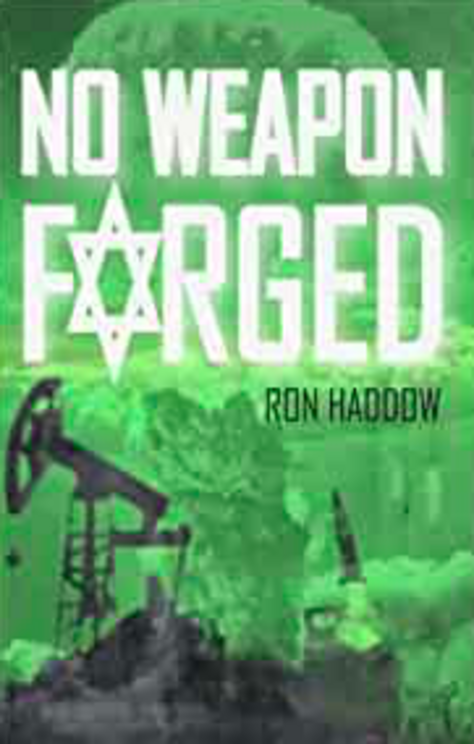
In 2009 I appealed to the UK’s Information Commissioner against the decision to redact the name plus that of the other intelligence officers involved. Working with Lib-Dem Member of Parliament (and former Cabinet Minister) Norman Baker, questions were raised in the House of Commons. But despite the public interest the MoD continued to maintain ‘the report was commissioned and produced…with strict security guidelines; at the time…it was a classified project with those involved being subject to the Official Secrets Act’. By that point I already knew that former GEC Marconi scientist Ron Haddow was the author, a fact now in the public domain thanks to Nick Redfern’s book (see FT 394: 31 for Jenny Randles account of Nick’s new theory). I hoped that Haddow, with the permission of his former employers, might be allowed to talk publicly about his controversial conclusion that UFOs existed and were an unknown type of natural phenomena linked to ball lightning. But as Haddow, now an octogenarian, refused to talk to me. As he had expressed a wish to maintain ‘a low profile’ I decided it was unethical to name him publicly. I did, however, warn Haddow that others – including several contributors to online UFO discussion groups – would eventually follow the same trail of clues that I had and discover his identity for themselves. By 2018 when the MoD declassified three remaining files covering the project, Fortean Time’s editor David Sutton and journalists at several national newspapers also become aware of his identity (Fortean Times 368: 26-29). One of them received confirmation from the MoD Press Office that Haddow was indeed the author of the report but decided not to publish this fact.

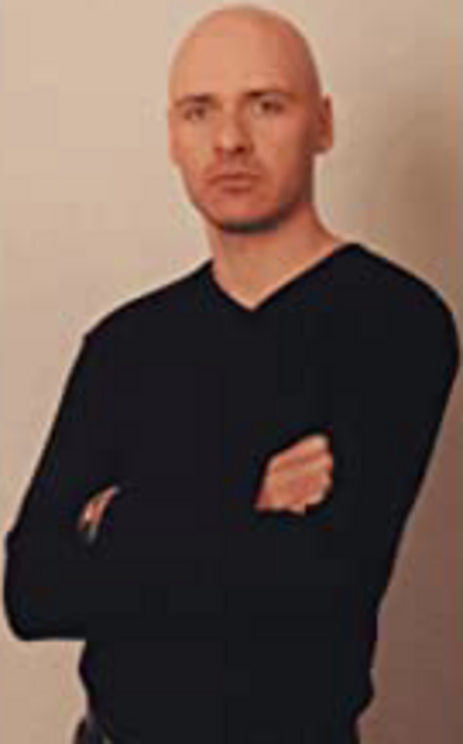
But as author Nick Redfern says in his new book The Rendlesham Forest UFO Conspiracy ‘nothing stays hidden forever’. And when the remaining files were released at The National Archives in 2018 they revealed another reason why Haddow remained wary of attention from both UFOlogists and the media. In 1999 a West Midlands UFOlogist, Irene Bott, phoned MoD Main Building to report a sighting and asked to be put through to the person responsible for UFOs. Present in the same room was Redfern, author of the 1997 book A Covert Agenda and at that time one of the MoD’s more persistent correspondents. Bott expected the switchboard operator to put her through to desk officer Gaynor South who was the only person officially acknowledged by Whitehall as responsible for UFO matters. But a mistake was made and, instead, her call was patched through to DI55 who were then based in another central London building. A man answered the phone. He said his name was Ron Haddow and it quickly became apparent that he was the person who investigated UFOs for MoD.
It is clear from the surviving transcript that Haddow was not happy. ‘Someone has given our (my) name and number,’ he wrote. ‘This could raise awkward questions since [the UFO desk] not long ago denied publicly that any work was going on. UFOlogists know about DI55 because of the [National Archives] and subsequent TV leaks…at best the name and telephone number will be throughout the UK ufologists in a matter of days’. And he adds: ‘at worst the press could get hold of it!...Any disparity in future responses will be seen by the UFO community as a “sensitive” cover up and only serve (in their eyes) as confirmation’.
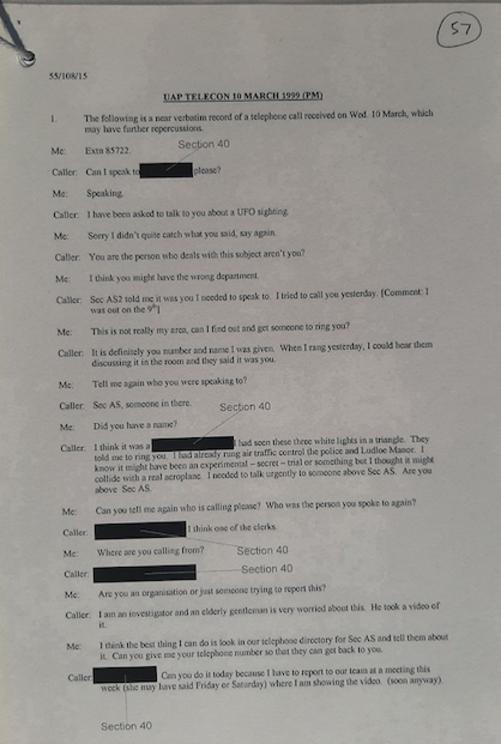
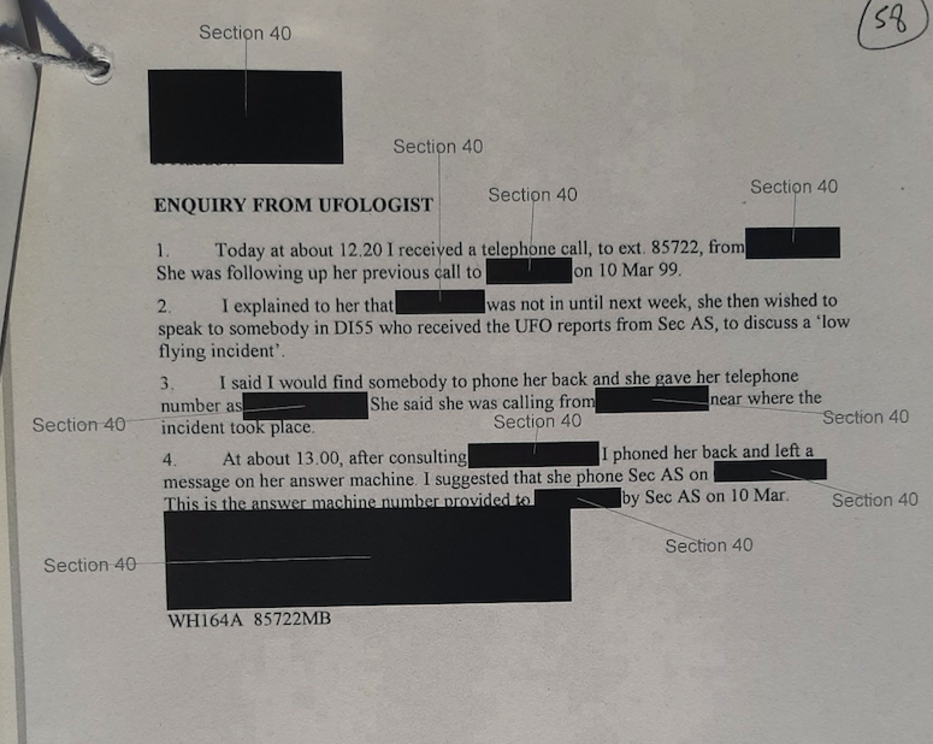
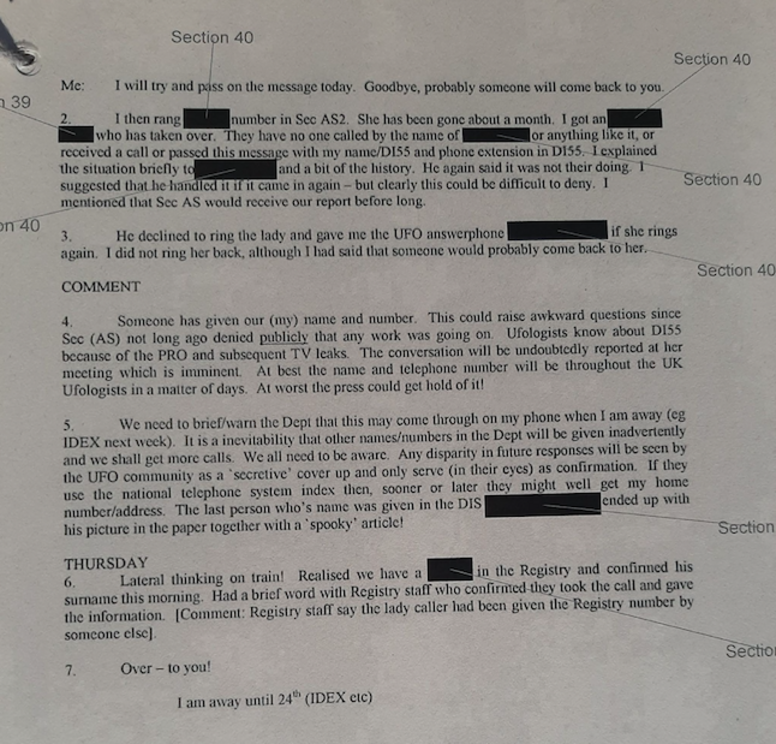
Luckily for him the press, at that time, were more interested in the views of the self-proclaimed ‘head of the British Government’s UFO project’, Nick Pope, who had recently published a book on alien abductions. I have no doubt this distraction worked well for Haddow and his employers despite their disapproval of Pope’s public pronouncements. But despite his clear desire to remain in the shadows Haddow had already discussed his own unconventional theories about UFOs at a religious event in Israel soon afterwards. And in 2006, after his retirement from MoD, Haddow published an intriguing novel – No Weapon Forged - ‘with a basis of biblical prophecy’ that was promoted by its publisher as ‘a compelling and entertaining read’ for fans of the Dan Brown’s Da Vinci Code. The blurb describes his novel as ‘a technically, militarily and historically authentic novel about a forthcoming Middle East conflict that is triggered by a dispute over oil. The scenario and weapons in use are frightening – but there is a prophetic twist at the end’.
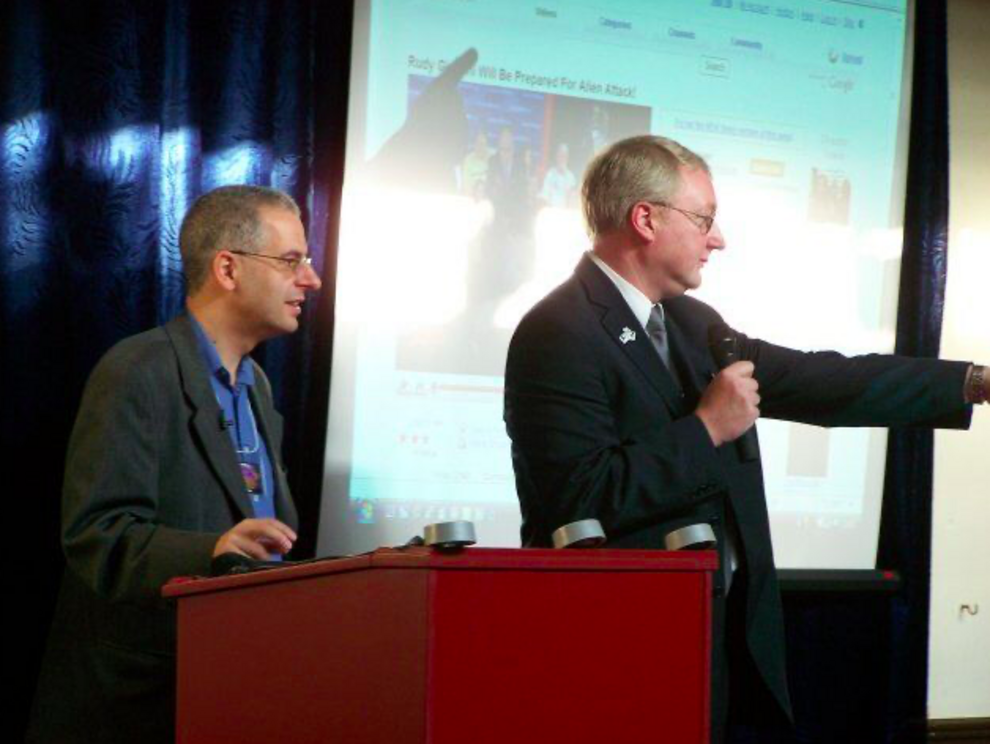
Redfern’s book lists No Weapon Forged as an example of a science fiction novel written by ex-MoD insiders that seeks to interweave a fictional plot with science fact. This literary tradition can be traced back to 1948 when ex-MI5 operative Bernard Newman published The Flying Saucer with a narrative based around crashes of alien spacecraft at remote locations across the world – including the New Mexico desert. In 1985 former MoD civil servant Ralph Noyes produced a novel, A Secret Property, that implied the existence of technology ‘that produces etheric visions of aliens and spaceships’ that ‘can affect the real world in real and hazardous ways’. In his MoD role Noyes helped produce a cover-story to hide the true function of the giant UK-US experimental radar station at Orfordness, code-named Cobra Mist, near the UFO-haunted Rendlesham Forest in Suffolk. As both Nick Redfern and Jenny Randles have concluded, Noyes clearly knew something unusual had happened in the forest but did not have access to the whole story. Using a cleverly plotted novel allowed him to avoid the pitfalls of the Official Secrets Act whilst keeping the subject in the public eye.
In the absence of Haddow’s own account what can we learn from the content of No Weapon Forged? It opens with a detailed biography of his career in defence intelligence that closely matches the information provided in his report and the remaining DI55 UFO files declassified by the MoD in 2018 (FT 368: 26-29). Sadly, the book makes no mention of UFOs or UAPs. But is does contain a surprising new fact that may explain the MoD’s reluctance to talk about him given the fact they had already had their fingers burned by Nick Pope’s new career in UFO punditry. Haddow had ‘a life changing experience’ at a talk on Biblical prophecy in 1982 and afterwards joined a Christian Zionist group. In October 2000 he was ‘one of just two scientists invited to speak by the International Christian Embassy at the Feast of Tabernacles in Jerusalem’. Did Haddow link his new-found religious beliefs with his interest in UAPs? An independent first-hand account of the Jerusalem feast, posted online by a Canadian delegate, provides a clue. It refers to an unusual talk by ‘a government spokesman’ who claimed that most UFO sightings can be explained by the ‘poorly understood phenomena’ of plasmas. ‘Some of these plasmas are man-made by aircraft with radar shield generators,’ the speaker said. ‘These have been in use since WW2 (foo fighters) but have only be declassified since the Kosovo war… The rest are tectonically generated (earthquake lights) or generated by meteor events in the upper atmosphere’.
Nick Redfern agrees that Haddow’s religious beliefs must have had some bearing on the MoD’s attempts to conceal his identity from the media and UFOlogy. He compares Haddow’s interests in End Times prophecies with those held by members of a military think-tank that once existed in the US Department of Defense who were ‘deep into UFOs but also into Old Testament-type religion’. Mixing UFOs with religion was always going to be controversial, Nick says, especially when ‘in a roundabout way, it leads to a secret UFO project’. He adds: ‘I can easily see how and why the MoD would want to keep all of this very low key’. Indeed, in his book Haddow implies the central character is based loosely upon his own life experiences in the Cold War. In doing so he reveals his interest in aircraft and guided missiles began in childhood when he heard a German V1 rocket impacted on a village near his home in Bedfordshire. He joined the RAF at 18 and in 1954 and took part in testing one of the earliest types of airborne radar. Later he took part in Operation Grapple, the British H-bomb test on Christmas Island and later, flew top secret missions in Canberras during the Cold War.
During this time he must have become aware of the Air Ministry and later MoD’s interest in UFO reports made by test pilots and RAF aircrew. Indeed, in one of the files he refers to having filed his own report with the UFO desk whilst on a RAF mission during the 1950s. No details of this incident have ever emerged from the MoD’s files. But Haddow’s expertise in Electronic Warfare, radar, air defence and guided weapons made him a perfect candidate for the MoD’s real UFO expert. In 1977 he was based at RAF Cranwell working as a specialist in guided weapons and his PhD thesis, completed in 1982, investigated ‘the probability of detecting and tracking radar targets in clutter at low grazing angles’, a handy technique for someone keen to capture evidence of UFOs on radar. During the 1980s Haddow was called upon to advise US intelligence on aspects of the Pentagon’s ‘Star Wars’ missile programme initiated by President Ronald Reagan. By the 1990s he was Chief Scientist for Systems at GEC-Marconi, the premier electronics company in the UK, now part of BAE Systems and visiting professor for the Royal Military College of Science.
According to his biography, ‘for the whole of this period he was also a consultant-analyst to a department in the MoD, travelling extensively for NATO, for industry and for government’. The MoD’s decision to ask him to return, one last time, to write their final report on UFOs must have some significance even if the Official Secrets Act continues to prevent him from saying anything else. The Condign report was Haddow’s swansong after a lifetime in the world of secret intelligence. His own words reveal that he was aware that it would become a source of speculation and debate for decades to come. But for now at least he remains in the shadows.

